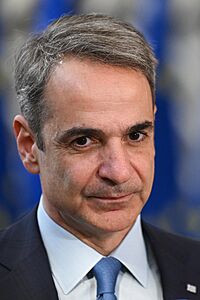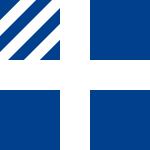Prime Minister of Greece facts for kids
Quick facts for kids Prime Minister of the Hellenic Republic |
|
|---|---|

|
|
|
|
| Style | His Excellency (formal and diplomatic) Mr Prime Minister (informal) |
| Member of |
|
| Reports to | |
| Residence | Maximos Mansion |
| Appointer | President of Greece |
| Term length | Four years, renewable |
| Inaugural holder | Spyridon Trikoupis |
| Formation | 13 January 1822 |
| Deputy | Deputy Prime Minister |
| Salary | €99,420 annually |
The Prime Minister of the Hellenic Republic is the main leader of the government in Greece. This person is also the head of the Greek Cabinet, which is a group of top government officials. People usually just call this role the Prime Minister of Greece.
The Prime Minister's official office is at the Maximos Mansion in the center of Athens. This building is used for work, but it is not where the Prime Minister lives. Sometimes, the office is also called the President of the Government.
Contents
How a Prime Minister is Chosen
The Prime Minister is officially picked by the President of Greece.
The Election Process
According to the Greek Constitution, the President of Greece chooses the leader of the political party that wins the most seats in the parliament. This is called having an absolute majority.
If no single party wins an absolute majority, the President first asks the leader of the party with the most votes (a relative majority) to try and form a government. This leader has three days to see if they can get enough support from other parties to lead the country.
If that doesn't work, the President then asks the leader of the second-largest party, and then the third-largest party, giving each three days.
What Happens if No Government Forms?
If none of these attempts work, the President calls all the party leaders together. If they still can't agree on a government, the President tries to form a special government made up of all parties. This government's main job would be to hold new elections.
If even that fails, the President asks a high court judge (from the Supreme Administrative Court, Supreme Civil and Criminal Court, or Court of Auditors) to form a temporary government. This temporary government's only job is to prepare for new elections after the President officially ends the current Parliament.
So, when people vote for a party's members in parliament, they are also voting for that party's leader to become Prime Minister.
Taking the Oath of Office
Before starting their job, the Prime Minister must take an oath. There are two ways to do this: a religious oath or a civil oath.
The Religious Oath
Most Prime Ministers take a religious oath at the Presidential Mansion. The Archbishop of Athens, who leads the Church of Greece, performs the ceremony.
The Archbishop starts with prayers. The Prime Minister-elect then places their hand on a Bible and recites this oath:
I swear in the name of the Holy, Consubstantial and Indivisible Trinity to safeguard the Constitution and the laws and to serve the general interest of the Greek People.
After more blessings, everyone makes the sign of the cross. The Archbishop congratulates the new Prime Minister, who then shakes hands with the President and signs the official papers.
The Civil Oath
In 2015, Alexis Tsipras chose a different path. He was the first Prime Minister to take a non-religious affirmation instead of the traditional oath. He was sworn in by President Karolos Papoulias, not the Archbishop.
Instead of the religious oath, he said:
Mr President, I would like to assure you, on my honour and conscience, that I will follow the Constitution and the laws and will always serve the general interest of the Greek People.
He then shook hands with the President and signed the documents. When Tsipras became Prime Minister again later that year, President Prokopis Pavlopoulos made the affirmation slightly more formal:
I affirm, on my honour and conscience, that I will follow the Constitution and the laws and will serve the general interest of the Greek People.
The Prime Minister's Official Office
The Maximos Mansion has been the official office for the Prime Minister of Greece since 1982. It is in central Athens, close to Syntagma Square. Even though it holds the Prime Minister's offices, it is not where the Prime Minister lives. The name Maximou is often used as a shortcut to refer to the Government of Greece.
A Brief History of the Office
The role of Prime Minister has changed a lot throughout Greece's history.
During the Greek Revolution (1821–1832)
During the Greek War of Independence, different parts of Greece that were free from Ottoman rule started setting up their own governments. They held meetings called National Assemblies to work together. The first assembly chose a five-person council, led by Alexandros Mavrokordatos.
Later, in 1828, Ioannis Kapodistrias became the "Governor of Greece." He was both the head of state and the head of government. After he was assassinated in 1831, his government fell apart. Greece was then led by various councils until 1833, when it became a monarchy.
Under King Otto (1832–1843)
In 1832, Greece became a monarchy with a young Bavarian prince named Otto as king. At first, a group of Bavarian advisers led the government. Their president, Count Josef Ludwig von Armansperg, was the main leader under Otto. Later, King Otto ruled by himself as an absolute monarch, meaning he had all the power.
Constitutional Monarchy (1843–1862)
King Otto's absolute rule ended in 1843 when people demanded a constitution. This event is known as the 3 September Revolution. Otto was forced to agree to a constitution, and Andreas Metaxas took power. He is often seen as the first person to officially serve as "Prime Minister" in Greece.
Once the Prime Minister's office was created, the Greek people had more say in their government. However, the king still had a lot of power because political parties were not very strong, and the king could choose almost any member of parliament to form a government.
The Crowned Republic (1863–1910)
In 1862, King Otto was removed from power, and the Greek people chose a new king, George I of Greece. Over the next 15 years, political parties started to become more organized. Charilaos Trikoupis led the more liberal New Party. After the election of 1874, Trikoupis successfully pushed for a new rule: the king had to choose the leader of the party with the most votes in parliament to be Prime Minister. This rule was called the "dedilomeni principle."
This period saw a two-party system until 1910, with the Nationalist Party and the New Party often competing.
Times of Change and Conflict (1910–1949)
In 1910, military officers caused the government to fall. This led to the rise of Eleftherios Venizelos, a politician from Crete. His supporters formed the Liberal Party, which was the first modern political party in Greece. It focused on new, liberal ideas and supported a republic (a country without a king).
The Liberal Party was opposed by the more traditional and pro-royalist People's Party. The struggle between these two parties, and between those who wanted a king and those who wanted a republic, shaped Greek politics until after World War II.
Stability and Royal Conflicts (1950–1967)
The Constitution of 1952 brought some stability in the 1950s after years of dictatorship, war, and civil war. However, the king still had significant powers, like being able to dismiss the government and parliament. This caused disagreements about who truly governed the country: the king or the elected Prime Minister.
Georgios Papandreou and his party, Center Union, became powerful in the 1960s. However, tensions grew between Papandreou and King Constantine II. The king wanted to control the army, while the elected government wanted more say. These disagreements, along with other political issues, led to a period of instability. Eventually, a group of military officers, known as the Colonels, took over the country and ruled for seven years.
The Third Hellenic Republic (1975–Present)
After the military rule ended, Constantine Karamanlis led the return to civilian government. In 1974, a vote was held, and the people decided to permanently abolish the monarchy.
A new Constitution was adopted in 1975. It created a parliamentary democracy where the President is the head of state, but the Prime Minister holds most of the power as head of government. Karamanlis made the Prime Minister's role stronger. The President kept some important powers, like calling elections or dissolving Parliament, but these were meant to be used carefully.
In 1985, Prime Minister Andreas Papandreou (Georgios Papandreou's son) made changes to the constitution. These changes further increased the Prime Minister's power by removing some of the President's special powers. This made the Prime Minister even more powerful in the government.
The Constitution has been updated several times since then, in 2001, 2008, and 2019, and it is still in use today.
See also
- List of prime ministers of Greece
- List of cabinets of Greece
- Politics of Greece



